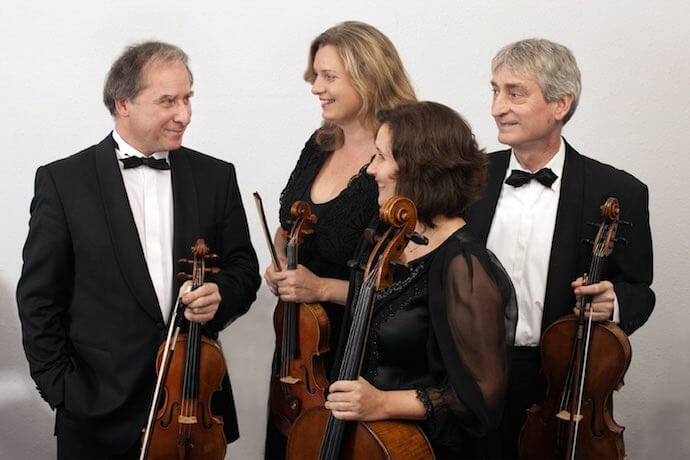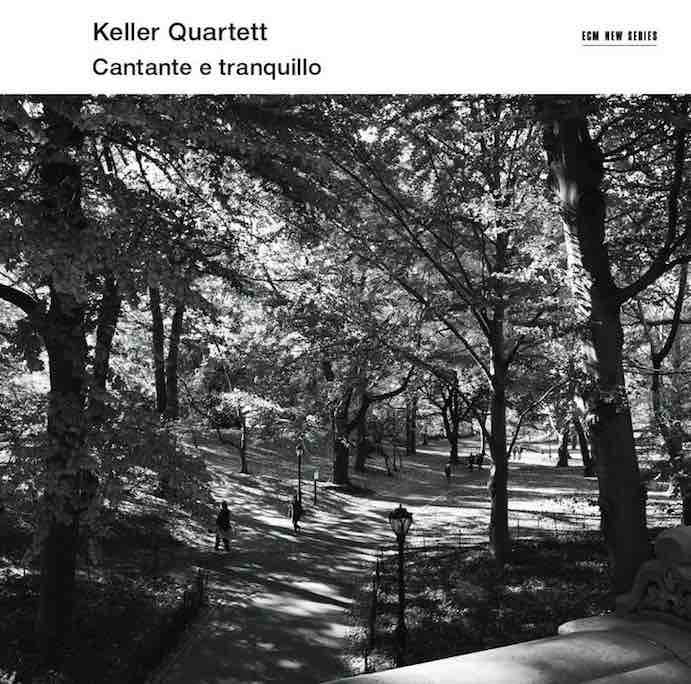Nobody should like this record and neither should I. This collection of string quartet music by Bach, Beethoven, Schnittke, Kurtag, Ligeti, and Alexander Knaifel is of the worst variety of whittling-down genius into mood music. It is something more than remotely akin to “Opera’s 101 Greatest Arias” or “Make Baby Smart With Mozart.” The only thing that sets it apart is how exquisitely it’s played and programmed.
Let’s start with the cover. Not fireworks but trees, and not the emaciated, black-metal, tall-and-slender, gasping-for-sunlight trees of the Nordic peninsula but the robust, tended-to trees of a planned, urban environment. There are streetlights and paved walkways. This could be Paris or Copenhagen or St. Petersburg or my neighborhood in upper Manhattan. It is a pleasantly innocuous depiction of a natural environment within the confines of man’s construction. It is, in a word, safe.
The music within, played by two lineups of the Keller Quartett, is likewise safe, sculpted to unobtrusively please, single movements plucked from works of genius and arranged like plants on a patio, presumptuously sanctimonious if it weren’t so satisfying; plucked also from past releases, making this a sort of greatest hits album if only the choruses of the hits were included.

Keller Quartett– Photo by Andrea Felvégi
The program opens with the sumptuous abstraction of the third movement of Beethoven’s String Quartet No. 16 (the expression mark of which gives the album its name) and slips away into the lovely adagio of the final movement of Ligeti’s String Quartet No. 2 before plunging into the mastery of Bach with the first contrapunctus from The Art of the Fugue. That second segue should have been a not inconsiderable upset but instead it rolls inexplicably smoothly. Three tracks in, however, there is a bug in the tonic because the only thing to listen to after Bach is more Bach. But like an insistent ice skater, the program 180s into Györgi Kurtág’s Aus der Ferne V, which somehow makes the subsequent Schnittke sound like a Kryzsztof Komeda theme, complete with the trademark love-it-or-leave-it sheen. Except that Schnittke put into that mournful piece, the final movement of his Piano Quintet, a Bach quotation, so now we are not dealing with incongruity but – as if the quartet were a cagey DJ – another sort of segue.
From there, we are plunged into the much lesser known known Knaifel, whose laboriously slow “An Autumn Evening” (excerpted from his In Air Clear and Unseen) bolsters the dream state: “They were playing Chopin but they also kinda weren’t,” “It was like I was in a basement but I was also outside.” And then a thankful return to dear Johann Sebastien with the unfinished final section of The Art of the Fugue, beautifully played at about the speed of sloth, falls inexplicably at about midpoint, its heart-emptying conclusion giving way to some Kurtág miniatures which sandwich the final movement of Beethoven’s String Quartet No. 13 (less the Grand Fugue) played so slowly it nearly liquified.
And as if the circle would be unspoken, we are treated to some more Kurtág minitatures before a return to the Beethoven’s “Lento assai, cantante e tranquillo” to conclude the collection. I’m not saying I approve of this CD but I enjoyed listening to it immensely.





















